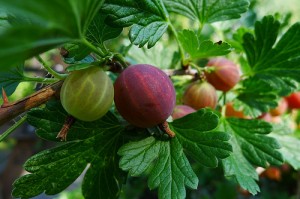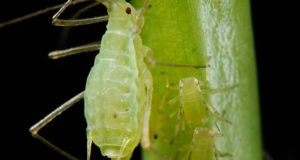Gooseberries have thorny, arching branches that grow to a height and spread of three to five feet. They flower from one-year-old wood and short spurs of older wood. Buds open to yield one to four blossoms. They are self-fertile and pollinated by wind and insects, but usually not by honeybees.
 Growing And Care
Growing And Care
Gooseberry bushes are hardy in zones 1-3. They thrive in well-drained, fertile, cool soils. Growing in warmer climates will require heavier soils that retain moisture well and keep cool. Organic mulch will help protect roots and keep soil moist and cool. Bushes will thrive in full sun or partially shady locations, but shaded bushes will not produce as many berries. In warmer areas plant in partial shade on a north-facing slope, if possible, to keep soil cool.
Gooseberries have only a moderate need for nitrogen. Excessive nitrogen promotes disease, especially mildew. The bushes have high requirements for potassium though. Potassium deficiency is indicated by scorching of leaf margins and can be avoided by dressing annually with half an ounce of potassium per square yard. Gooseberries also have a high requirement for magnesium, so add lime to the soil use dolomitic limestone. This adds magnesium as well as calcium. Plant gooseberries four to six feet apart; actual distance depends on richness of soil and cultivar chosen. They should not be planted as a continuous hedge as the branches of adjacent bushes will interlace, making it difficult to harvest and prune. As they leaf out early, bare roots should be planted in fall or as early as possible in late winter or early spring.
Pruning
Gooseberries are grown in two ways: on a permanent, short “leg” – a trunk that is about six inches long—or as a “stool” – a bush continually renewed with new shoots arising at or near ground level.

The advantage to the trunk is that fruit are kept off the ground, keeping it clean and making weed control, picking, and spraying easier. The risk is possible loss of the whole plant should the trunk be damaged. Stooled plants live longer and produce more – yet smaller – berries.
The shape chosen should reflect the growing site. For example, in warmer, sunnier locations the long branches of stooled bushes provide leaf protection to protect berries from sunscald. Regardless of growing method, berries should only be born on wood that is less than four-years old.
When growing stooled bushes, cut away all but six of the previous seasons shoots in late winter. Do the same in the second and third winters. After the third pruning, the bush will have six each of one, two, and three-year-old stems. This is the status you want to keep on all of your gooseberry bushes. In following years you will prune away all the four-year-old wood and all but six of the most vigorous, upright new shoots growing up from ground level. You may also shorten any long shoots, if desired.
If you grow plants on a trunk, begin training during late winter after the first growing season. Remove (at ground level) all but three or four vigorous, upright branches. Remove buds on these from ground level to six inches above ground. Stake the bush to keep it upright – I would braid the stems before staking, as this will strengthen and add a decorative touch to the trunk. Nip out the tip of the stems when they are two to three feet high. Side branches will begin forming below the cuts.
White Patches = Trouble
The most serious disease for gooseberries is powdery mildew. They can destroy the berries overnight on susceptible plants when nights are cool, days are clear, and spores are present. Powdery white patches (which turn gray) appear on leaves and berries. Treat powdery mildew on susceptible varieties with this spray:
- 1 tablespoon ultra-light horticultural oil
- 1 tablespoon baking soda
- 1 teaspoon dish detergent
- 1 gallon warm water
Mix well. Spray weekly on infected plants. Water them thoroughly two days prior to spraying. Don’t apply in full sun. Test on a small area to check the plant’s response to it. Apply to entire plant, including the underside of the leaves. Do not store unused portions.
Another way to eliminate mildew is by cutting dormant plants to the ground, cleaning up all debris, and planting your other gooseberries in another location far from the infected area. (Lilac and rose mildews are not threats to gooseberries, they are caused by different fungi.) In addition, mildew-resistant varieties have been developed.
Gooseberries are also threatened by leaf spot. This first causes the spots it is named for, then loss of leaves. Leaf loss occurs late in the season and can be ignored with no great harm to the plants. Some have effectively used applications of Bordeaux mixture just after leaves appear. Others have used lime-sulfur sprays to a less degree of effectiveness. You can google “organic replacements for” Bordeaux mixture and lime-sulfur sprays to keep your plants chemical free.
Two insects that require attention are currantworm and gooseberry fruitworm. Even if your berry patch is well established, these pests will eventually find their way into your garden. Currantworms begin working as the leaves expand in spring. They chew through and quickly strip the leaves from the bushes. Rotenone – an organic insecticide – applied as soon as damage is detected will control currantworms. Additional sprayings may be necessary if second or third generations become a problem.
Gooseberry fruitworms damage berries, not leaves. Just before they ripen, the fruitworms burrow into the berries, eat the pulp, exit, and spin a silk web joining fruits (and sometimes the leaves) together. Damaged fruits color prematurely. A beneficial, microbial spray containing Bacillus thuringiensis, like Turicide or Dipel, applied when webs are first sighted, control fruitworms.
Propagation
Gooseberries propagate easily from cuttings – American varieties easier than European ones. Take hardwood cuttings in early fall, before all the leaves have fallen from the branches – the presence of leaves actually enhances rooting. Cuttings should be about a foot long, not including tip growth. Bury so that only the top bud is exposed. Mulch heavily after ground freezes. Remove the mulch in early spring.
Harvesting
Harvesting can begin the first week in July, depending on region and weather condition. Hold back a branch with one hand sheathed in a sturdy leather glove. Carefully pick with the other hand to avoid the vicious thorns. Gooseberries are tasty picked and eaten right from the bush or used in jellies, jams, and desserts.
Pick and enjoy the way you like best. Happy gardening!
©2011 Off the Grid News
 Off The Grid News Better Ideas For Off The Grid Living
Off The Grid News Better Ideas For Off The Grid Living



